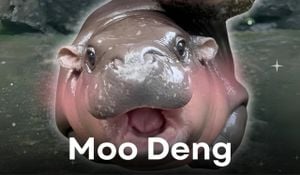Norwegian waters were recently rocked by the death of Hvaldimir, the much-beloved beluga whale whose fame rose to near-legendary status after he was spotted near Norway sporting what many believed to be spy gear. But the mystery surrounding his life came to a tragic end on August 31, when he was found floating lifelessly in a bay of southern Norway. Speculation about foul play circulated by animal rights groups fueled concern and grief among the public, but the truth behind Hvaldimir's demise has emerged following thorough investigations and autopsy results.
Norwegian police confirmed on October 4, 2024, the likely cause of Hvaldimir's death was not as sinister as many had feared. Amund Preede Revheim, head of the North Sea and Environment section of the police, stated, “The probable cause of death was a bacterial infection—possibly due to a wound from something like a stick lodged in the whale's mouth.” This assessment dispelled rumors circulated by various animal rights groups, which had claimed the whale was shot.
This information didn’t come lightly; the process for determining Hvaldimir’s cause of death was far from straightforward. The Veterinary Institute of Norway had to battle the decomposition of the whale's organs, severely complicate their analysis. Nor was any evidence of lethal projectiles discovered after X-rays were conducted. Revheim stated, “There have been no findings from the autopsy indicating the whale has been shot.” And reassured the community, noting, “No reason exists to launch any criminal investigations.”
Hvaldimir had captured the hearts of many since he first appeared off Norway’s coast way back in 2019. Known to be gentle and friendly, the whale was often spotted swimming and playing among local fishermen, with several people even sharing personal anecdotes about close encounters with him. His identifying mark was his distinct harnesse, marked with “Equipment St. Petersburg,” which sparked theories about his past possibly involving the Russian military. His nickname touches not just on his nature as a whale but also cheekily combines the Norwegian word for whale—hval—with the name of Russian President Vladimir Putin.
Animal rights groups, including OneWhale and NOAH, had eagerly followed Hvaldimir's story over the years and were devastated by the news of his death. Just weeks before his passing, these organizations filed formal complaints alleging the whale had been intentionally harmed based on multiple wounds found on his body. They claimed at least one of these wounds resembled what could be interpreted as a gunshot wound. Their disappointment deepened when police and veterinary reports ruled out such violence as the cause of his demise.
To support their cause, groups like OneWhale pointed to Hvaldimir's wounds as evidence of possible wrongdoing. “The so-called bullet hole was actually assessed by forensic technicians, who affirmed it did not originate from any firearm; no metal fragments or projectiles were detected. Instead, their analysis pointed out one significant injury—a stick almost 14 inches long found wedged deep within Hvaldimir’s mouth,” police explained during their investigations.
Hvaldimir's story gained significant media traction, especially after reports indicated he might have been trained by the Russian military, aiming to weaponize marine mammals. These allegations harken back to historical examples of military involvement with animals, including dolphins engineered for combat. The concept of Hvaldimir as some kind of “spy whale” captivated both animal enthusiasts and military analyst groups alike.
The public's affection toward Hvaldimir was evident, as he became emblematic of the intersection between wildlife and geopolitical intrigue. Hvaldimir's playful nature and friendly demeanor had made him not only the focus of scientific studies about the well-being of marine fauna but also of heartfelt connections among locals. People would gather to watch him surf through the water, perform tricks, and enjoy life by the coast.
This close-knit bond was highlighted when the groups working for Hvaldimir expressed grief over his passing. OneWhale stated after the findings, “The manner of Hvaldimir’s death does not impact the comprehensive work we have performed to protect him and advocate for his well-being over the last five years.” The organization highlighted the collaborative efforts made with Norwegian scientists, veterinarians, and the government to secure Hvaldimir’s health throughout the years, ensuring they took every measure to protect him.
Interestingly, after his body was discovered, supporters and scientists urged authorities to continue monitoring the health and behaviors of other marine wildlife, ensuring no similar tragedies befall them. Experts cited the importance of disentangling marine life from human impacts, especially as environments face increasing pollution and threats from climate change.
Fortifying bonds between humans and nature is more pressing than ever, especially when events like Hvaldimir's story bring to light the challenges facing these beautiful creatures. Their plight serves as both a reminder of responsibility and obligation toward the earth's wildlife. Hvaldimir's life—and subsequent death—sparked debates about the ethics of animal welfare and military practices entwined with natural habitats.
Despite the pained circumstances of Hvaldimir's death, he undeniably left behind a legacy of passion, awareness, and advocacy for marine animals. He remains etched in the hearts of many, providing hope for other endangered species caught between technology, politics, and the nurturing they require to thrive. Because of Hvaldimir’s story, the conversation about marine ecosystems and protection will continue, honoring the influence he had during his short but impactful life.



